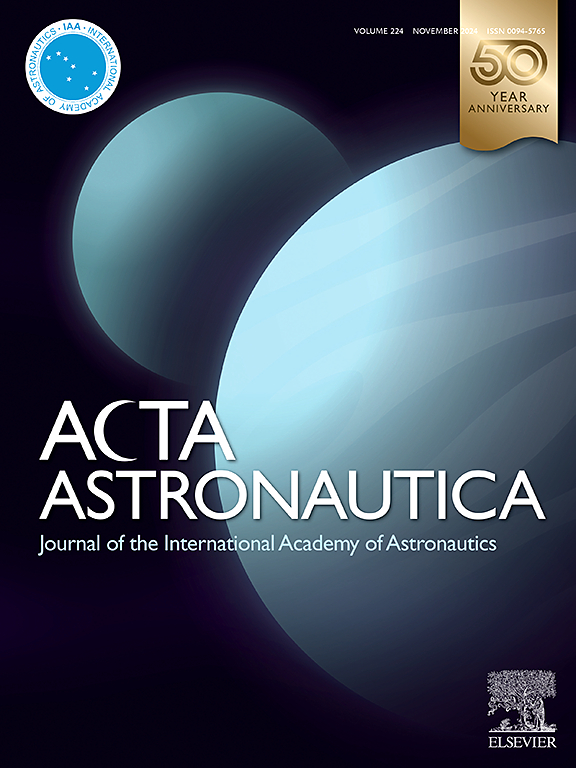合成热图像生成和处理,用于近距离操作
IF 3.1
2区 物理与天体物理
Q1 ENGINEERING, AEROSPACE
引用次数: 0
摘要
即将到来的太空任务中预计会出现的新情况增加了人们对基于光学的相对导航技术的兴趣,这些技术已在各种操作条件下证明了其有效性。虽然物体探测方法主要是在可见光谱范围内使用,但光学有效载荷在微弱的照明条件下很难发挥作用,而且容易受到过度曝光的影响。因此,热成像系统正被作为一种潜在的解决方案进行研究,因为将其集成到现有系统中将大大扩展未来的任务能力。本研究试图通过评估最先进的物体检测算法在热光谱图像中的性能来填补文献空白。鉴于在轨捕获的现成热红外(TIR)图像很少,因此采用了一种新颖的渲染流水线来生成与近距离场景相关的物理上精确的热图像。这些合成图像以地球和深空背景下的简化目标航天器为特征,包括光照条件、材料属性、相对状态和比例的变化。为确保输出结果逼真,根据云层和地球辐射能量系统(CERES)数据库中收集的卫星测量数据对地球辐射场进行建模。为了提高输出结果的保真度,在管道中引入了热传感器模型和相应的噪声水平。生成的图像随后用于测试传统物体检测算法在不同轨道场景下辨别感兴趣区域(ROI)的性能。结果表明,所选方法能够有效减轻地球在 ROI 提取过程中的影响,同时也揭示了由于多材料目标的存在而导致的性能下降。本文章由计算机程序翻译,如有差异,请以英文原文为准。
Synthetic thermal image generation and processing for close proximity operations
The new scenarios foreseen in forthcoming space missions have increased interest towards optical-based relative navigation techniques, which have demonstrated efficacy in a variety of operational conditions. Although object detection methods have predominantly been used within the visible spectrum, optical payloads struggle in weak lighting conditions and are susceptible to overexposure. Consequently, thermal imaging systems are being investigated as a potential solution, as their integration into the current systems would greatly extend future mission capabilities. This study seeks to fill the gap in literature by assessing the performance of state-of-the-art object detection algorithms with images captured in the thermal spectrum. Given the scarcity of readily available thermal infrared (TIR) images captured in orbit, a novel rendering pipeline is implemented to generate physically accurate thermal images relevant to close-proximity scenarios. These synthetic representations feature a simplified target spacecraft against Earth and deep space backgrounds, including variations in illumination conditions, material properties, relative state, and scale. To ensure realistic outputs, the radiative field of the Earth is modelled based on satellite measurements collected in the cloud and Earth radiant energy system (CERES) database. To enrich the fidelity of the outputs, a thermal sensor model and the corresponding noise levels are introduced in the pipeline. The generated images are then used to test the performance of traditional object detection algorithms in discerning the region of interest (ROI) under different orbital scenarios. The results demonstrate the effectiveness of the selected methodologies in mitigating the influence of the Earth in the ROI extraction process, while also revealing a performance degradation due to the presence of multi-material targets.
求助全文
通过发布文献求助,成功后即可免费获取论文全文。
去求助
来源期刊

Acta Astronautica
工程技术-工程:宇航
CiteScore
7.20
自引率
22.90%
发文量
599
审稿时长
53 days
期刊介绍:
Acta Astronautica is sponsored by the International Academy of Astronautics. Content is based on original contributions in all fields of basic, engineering, life and social space sciences and of space technology related to:
The peaceful scientific exploration of space,
Its exploitation for human welfare and progress,
Conception, design, development and operation of space-borne and Earth-based systems,
In addition to regular issues, the journal publishes selected proceedings of the annual International Astronautical Congress (IAC), transactions of the IAA and special issues on topics of current interest, such as microgravity, space station technology, geostationary orbits, and space economics. Other subject areas include satellite technology, space transportation and communications, space energy, power and propulsion, astrodynamics, extraterrestrial intelligence and Earth observations.
 求助内容:
求助内容: 应助结果提醒方式:
应助结果提醒方式:


